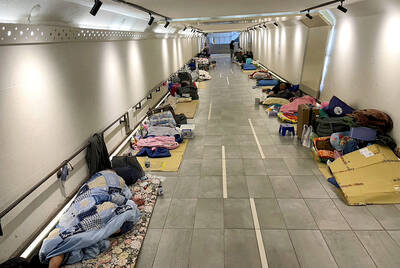If you want to know how big an upgrade the M3GAN sequel has on the original, look no further than the very first scene. M3GAN was mostly set in a Seattle house, but M3GAN 2.0 starts at the Turkish-Iranian border — with a murderous rampage in a secret military installation and the presence of Saudi intelligence, with U.S. Defense Department officials covertly watching.
Two hours later, it’s not clear if this is really an upgrade.
Most of the same team that gave us the refreshing horror-comedy original two years ago have not only gone super-big, but also changed the franchise’s genre, turning M3GAN 2.0 into an action movie with two AI robots, two villains, FBI units, wingsuits, neural implants, a Mission: Impossible”-style vault heist, exosuits, a 250-mph street chase in a supercar, a power grid disaster, a countdown clock, the UN and the fate of the planet at stake.

Photo: AP
If the evil doll M3gan in the first movie was responsible for the deaths of four humans and one dog, this time the screen is littered with the corpses of shootings, decapitations, severed limbs and laser slayings. There are double-crosses, impalings, blood splatter, cattle prods, tactical military soldiers, self-destruct sequences and insane close-combat martial arts. You can be forgiven for expecting a Tom Cruise appearance.
What you won’t get is much of the vibe of the original, which fused horror, cultural commentary and humor. This time, that’s muted in favor of an overly ambitious, horribly convoluted plot that sometimes feels like the moviemakers just threw money at the sequel and tried to ape other franchises by going massive. The first had a bedroom feel; the new one starts, like we said, on an international border. The original’s US$12 million budget has been tripled.
M3GAN 2.0 owes a lot to Terminator 2: Judgment Day, in which the robot killer in the first movie becomes the robot hero of the second. M3gan, it will come as no surprise, wasn’t killed at the end of the original. She’s just been laying low, waiting for her time to seize the day — and dance. Now she is reborn to fight another, better AI robot, played with sinister lethality by Ivanna Sakhno.
M3GAN arrived in 2023 just as AI technology like ChatGPT was beginning to go mainstream. Director and screenwriter Gerard Johnstone turns Allison Williams — who plays M3gan’s creator, Gemma — into a high-profile author and advocate for government oversight of artificial intelligence as the sequel opens. One of the more intriguing questions the movie explores is if parents are gradually outsourcing their responsibilities to technology.
Her niece Cady — the fabulous Violet McGraw — is now a budding computer programmer and rebellious. She has learned aikido and has a strong affinity for Steven Seagal, a running gag. Her protection is still the single focus of M3gan, who has apparently been in cloud networks between movies.
Facing a global existential threat, Gemma is convinced to build a body for M3gan to go toe-to-toe with the military-grade AI killing machine known as Amelia.
“Everyone deserves a second chance,” Cady tells her aunt. But whose side is M3gan really on? Wwhat does Amelia really want?
Some of the movie’s best parts are when M3gan and Amelia face off. “You’re not family to them,” the new AI model says to the old. “You’re just the help.” There’s some cool robotic dancing — a highlight of the original — and a return of M3gan’s camel-colored silk sateen dress that became popular at Halloween.
Johnstone has smartly kept the offbeat humor of the original, this time with clever nods to Knight Rider and a surreal use of the Kate Bush song This Woman’s Work. Jemaine Clement from Flight of the Conchords has fun as an arrogant tech billionaire, while Brian Jordan Alvarez and Jen Van Epps return as Gemma’s tech teammates, this time crawling through ducts or getting choked almost to death.
We wouldn’t be here if someone had taken the advice of Ronny Chieng’s character in the original movie: “I want you to take this cyborg puppet show and put it in a dark closet where it belongs.” Not after grossing US$180 million worldwide. M3GAN 2.0 was inevitable, but it didn’t have to be so inevitably too much.

From the last quarter of 2001, research shows that real housing prices nearly tripled (before a 2012 law to enforce housing price registration, researchers tracked a few large real estate firms to estimate housing price behavior). Incomes have not kept pace, though this has not yet led to defaults. Instead, an increasing chunk of household income goes to mortgage payments. This suggests that even if incomes grow, the mortgage squeeze will still make voters feel like their paychecks won’t stretch to cover expenses. The housing price rises in the last two decades are now driving higher rents. The rental market

July 21 to July 27 If the “Taiwan Independence Association” (TIA) incident had happened four years earlier, it probably wouldn’t have caused much of an uproar. But the arrest of four young suspected independence activists in the early hours of May 9, 1991, sparked outrage, with many denouncing it as a return to the White Terror — a time when anyone could be detained for suspected seditious activity. Not only had martial law been lifted in 1987, just days earlier on May 1, the government had abolished the Temporary Provisions Effective During the Period of National Mobilization for Suppression of the Communist

Hualien lawmaker Fu Kun-chi (傅?萁) is the prime target of the recall campaigns. They want to bring him and everything he represents crashing down. This is an existential test for Fu and a critical symbolic test for the campaigners. It is also a crucial test for both the Chinese Nationalist Party (KMT) and a personal one for party Chairman Eric Chu (朱立倫). Why is Fu such a lightning rod? LOCAL LORD At the dawn of the 2020s, Fu, running as an independent candidate, beat incumbent Democratic Progressive Party (DPP) lawmaker Hsiao Bi-khim (蕭美琴) and a KMT candidate to return to the legislature representing

Fifty-five years ago, a .25-caliber Beretta fired in the revolving door of New York’s Plaza Hotel set Taiwan on an unexpected path to democracy. As Chinese military incursions intensify today, a new documentary, When the Spring Rain Falls (春雨424), revisits that 1970 assassination attempt on then-vice premier Chiang Ching-kuo (蔣經國). Director Sylvia Feng (馮賢賢) raises the question Taiwan faces under existential threat: “How do we safeguard our fragile democracy and precious freedom?” ASSASSINATION After its retreat to Taiwan in 1949, the Chinese Nationalist Party (KMT) regime under Chiang Kai-shek (蔣介石) imposed a ruthless military rule, crushing democratic aspirations and kidnapping dissidents from